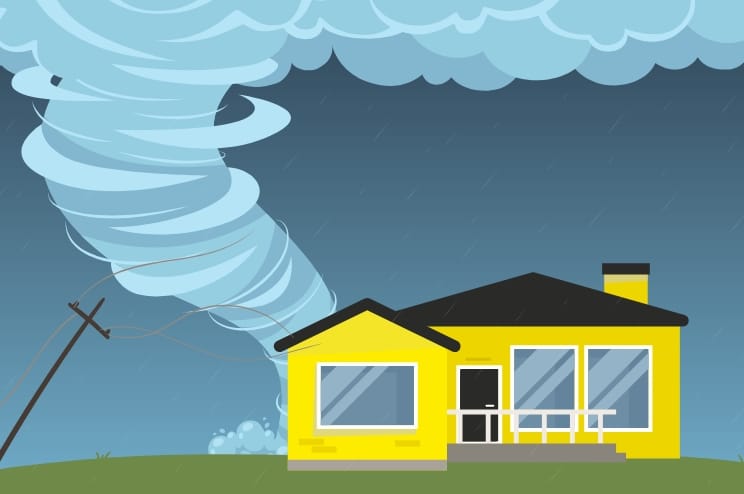With summer storms becoming increasingly unpredictable, protecting your home from potential storm damage is more important than ever. But many homeowners wonder how exactly to do that… After all, everybody likes a property that stays in one piece! Today, let’s take a look at how to prepare your house for its next run-in with a wild weather event.
Understanding Storm Damage
First of all, what kind of risk does a storm pose for a home? Well, storm damage can come in several ways, depending on the storm’s severity and your home’s resilience. Common types of storm damage include:
Wind Damage: High winds can lift roofing materials, break windows, and even dislodge siding.
Hail Damage: Hailstones can dent roofs, crack siding, and shatter windows.
Rain Damage: Persistent heavy rains can lead to leaks, water intrusion, and flooding.
Debris Impact: Flying debris can cause physical damage to roofs, siding, and windows.
The consequences of such damage can be costly, leading to expensive repairs and, in severe cases, compromising your home’s safety.
Roofing Solutions for Storm Protection
Your roof is your home’s first line of defense against storm damage. And ensuring it is sturdy and well-maintained is one of the best ways to protect it. Here are some roofing materials known for their storm resistance:
Asphalt Shingles: Asphalt shingles are a popular choice for many homeowners due to their affordability and versatility. They provide a good level of protection against wind and rain when properly installed and maintained.
Metal Roofing: Metal roofing does not budge easily. This is because it is typically installed in larger sheets, making it hard for wind to get under it and cause lift.
Impact-Resistant Shingles: Specifically designed to handle severe weather, these shingles are tested for their resistance to impacts and high winds, making them perfect for homes near trees or prone to hailstones.
Siding Materials for Storm Protection
Siding also plays a crucial role in protecting your home’s exterior from storms. Just like with roofs, there are many different materials that offer unique protection. We’ll name a few:
Vinyl Siding: Vinyl siding is by far the most common kind of siding for residential structures. When installed properly, it provides a great defense against the wind and rain. But here’s the thing, even small compromises like holes or unhooked sections can lead to major failures.
Fiber Cement Siding: If there is one type of siding known for its exceptional durability and ability to withstand severe weather conditions, it’s fiber cement. It is resistant to high winds, hail, and even fire…yes, fire. While it may be a bit pricey, it is one of the most durable and long-lasting options.
Engineered Wood Siding: Wood looks nice, but it’s not really a good option for those who want longevity. That’s why engineered wood siding exists. This material combines the natural look of wood while keeping the protection power of vinyl or cement. Engineered wood siding is treated to resist moisture, insects, and impact damage, making it a resilient choice for homes in storm-prone areas.
Maintenance Tips for Storm Preparedness
Before we go, let’s talk about regular maintenance. Because even with the best of materials, nothing can replace the importance of regular up-keep. Here are some tips to keep your home in tip-top condition:
- Regular Roof and Siding Inspections: Check for any signs of wear and tear, such as loose shingles or cracked siding, and address them promptly.
- Gutter Cleaning and Maintenance: Ensure gutters are clear of debris to prevent water buildup and potential leaks.
- Securing Loose Outdoor Items: Store or secure items like patio furniture, grills, and garden tools to prevent them from becoming projectiles during high winds.
What’s the Takeaway?
Remember, proactive measures are the best way to protect your home from storm damage. By choosing the right materials for your roof and siding and maintaining your home regularly, you can minimize the risks associated with most storms that come your way. Stay protected!
Need help figuring out how to keep your home’s exterior safe? Walker Roofing and Siding is just a call away!
Frequently Asked Questions
Q: What is the best roofing material for storm-prone areas? A: Impact-resistant shingles and metal roofing are highly recommended for their durability and ability to withstand severe weather conditions.
Q: How often should I inspect my roof and siding for damage? A: It’s advisable to inspect your roof and siding at least twice a year, and after any major storm, to catch and repair any damage early.
Q: What are the signs that my siding needs to be replaced? A: Look for cracks, warping, loose panels, or signs of water damage. If you notice any of these issues, it may be time to consider new siding.
Q: How can I improve my home’s drainage system to prevent storm damage? A: Regularly clean your gutters, ensure downspouts direct water away from your foundation, and consider installing a French drain or other drainage solutions to manage heavy rainfall.

